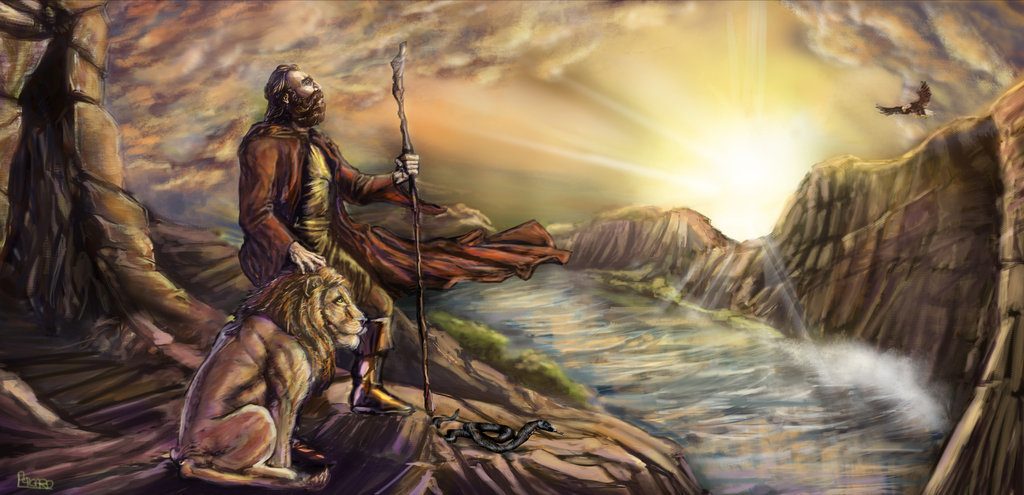Zoroastrianism was a dualist faith that originated in Persia, and over the years it has influenced a number of other faiths. Even though we may not recognize it today, it has been an influence on a number of world religions, especially on Christianity and Islam. Zoroastrianism is a belief system that stresses how we as human beings were meant to strive for our full potential. A primary tenet of the faith is that righteous and upstanding people will participate in the rewards of paradise, while the evil-doers will undergo punishments in hell.1
The prophet and founder of Zoroastrianism was Zarathustra, a man from an aristocratic family in Rhages, Media. Most scholars believe that Zarathustra was born around the late seventh and early sixth centuries B.C.E. He was a priest who became disillusioned with Persian ancestral religion, so instead he decided to search for inspiration and wisdom, and for a deeper meaning to life. After ten years of traveling, he finally realized that he had been called to be a prophet of Ahura Mazda, the Lord of Light. “He received a revelation in the form of the Avesta, the holy book of his religion, and commissioned to preach to humankind.”2 He would preach the Gathas; these were known as the hymns to the gods.
The central claim of Zoroastrianism is that there are two coequal and co-eternal gods: Ahura Mazda, the All-knowing Lord of Light, and Angra Mainyu or Ahriman, the Lord of Darkness. These gods represent an extreme dualism, where followers were given the option of choosing whom to worship. Ahura Mazda would save or condemn individuals based on whichever choice they decided to make.3 The people would experience rewards and punishments based on how they chose to behave. If they followed “Good words, Good thoughts, Good deeds,” they would be able to appreciate all the pleasures Ahura Mazda had in store for them in the afterlife.4

Devotees of Zoroastrianism believed that Ahura Mazda first produced the World of Thought and then gave birth to the World of the Living; but there was not yet life. Angra Mainyu challenged this pre-creation with his own counter-creation in order to destroy what Ahura Mazda was establishing. The Lord of Darkness wanted to demolish it with darkness, sickness, and death. Before Angra Mainyu was able to attack, Ahura Mazda forced him to recoil to the darkness. He was stunned into unconsciousness for three thousand years.5
Ahura Mazda then prepared for the Mixture of war, or battles against evil. This war was going to last six thousand years. For the first three thousand years, Ahura Mazda would unite with other lesser gods so that they could form a broad alliance. Angra Mainyu’s evil queen helped awaken the evil-doer and stirred all evil beings to attack Ahura Mazda. The battle then began, and Ahura Mazda’s creation came to life. Unfortunately, the very first beings killed were good, Gayomard and the Lone Bull; but from their semen they were able to manifest all humankind and bring into being all animals. Ahura Mazda’s right-hand man was Karsasp, a beautiful and innocent man, who helped fight off Angra Mainyu and his servants. Ahura Mazda then put Karsasp into a deep sleep so he would be well-rested for the very Last Battle.6 “At death, according to the tenets of Zoroastrianism, the souls of all persons ascend to the summit of Mount Hara where the good and bad of each soul are weighed in balances.”7 If one has made exceptional choices, ones soul will cross the cosmic bridge and continue an existence in heaven. In the case that many of one’s decisions were unacceptable, the bridge will disrupt and one’s soul will perish in hell. Scholar Charles David Isbell summarizes the eschatology of Zoroastrianism this way: “Since evil will have become extinct, history will come to an end, good souls will receive immortal bodies and will live forever in the re-perfected earth ruled over by Ahura-mazda.”8
This religion has continued to be practiced for as much as three thousand years. There are still a few thousand devotees that continue to carry on the traditions of Zoroastrianism in Iran and in India today. This religion has faced many difficulties in its long history, especially during the seventh century C.E. when invading Arab Muslims conquered the land of Persia, the homeland of Zoroastrianism. The conquerors chose not to take away this religion altogether, but they did choose to put a financial burden on the Zoroastrian temples.9 Many fled to India, which is home today to many of their descendants, known as Parsis. Many of those who stayed in Persia ended up converting to Islam. Although it may not be practiced as widely today, it has made a considerable impact on other religions.
Christianity was one of those religions that may have been influenced by elements within Zoroastrianism. Scholar John R. Hinnells writes,
It is generally held that the form of the later Jewish and Christian concept of the devil or Satan was influenced by Iranian tradition. If this be accepted then it has serious implications for the understanding of the saviour or Messianic figure…. When [the devil] becomes truly demonic … then the savior is given a new task.10
That task, Hinnells believes, was to defeat a supernatural and evil being, which taps into Zoroastrian dualism. In fact, the beliefs in a Satan of evil pitted against a God of good, the belief in angels and demons fighting a cosmic war, and the belief in a savior figure who would save all of humanity from evil and sin are all elements deriving from Zoroastrianism.11 Zoroastrianism in its original form may be an obscure faith in today’s society, but its impact on the fundamental principles of many religions is evident and deserves our appreciation and acknowledgement.
- Jerry Bentley, Herbert Ziegler, Heather Streets Salter, Traditions & Encounters: A Brief Global History Volume 1 (New York, NY: McGraw-Hill Publishers, 2016), 95-99. ↵
- Salem Press Biographical Encyclopedia, 2015, s.v. “Zoroaster,” by J. Steward Alverson. ↵
- Funk & Wagnalls New World Encyclopedia, 2016, s.v. “Ahura Mazda.” ↵
- Bentley, Ziegler, and Street Salter, Traditions & Encounters, 96-97. ↵
- P. Oktor Skjærvø, “Good vs. Evil,” Calliope 15, no. 5 (January 2005): 8. ↵
- P. Oktor Skjærvø, “Good vs. Evil,” Calliope 15, no. 5 (January 2005): 8. ↵
- Charles David Isbell, “Zoroastrianism and Biblical Religion,” Jewish Bible Quarterly (2006). ↵
- Charles David Isbell, “Zoroastrianism and Biblical Religion,” Jewish Bible Quarterly (2006). ↵
- Bentley, Ziegler, and Street Salter, Traditions & Encounters, 97-98. ↵
- John R. Hinnells, Zoroastrian and Parsi Studies: Selected Works of Johr R. Hinnells (Burlington, VT: Ashgate Publishing Co., 2000), 46. ↵
- Bryan Rennie, “Zoroastrianism: The Iranian Roots of Christianity,” The Council of Societies for the Study of Religion vol. 36 no. 1 (2007): 3-5. ↵



89 comments
Sudura Zakir
The context of this article is interesting and shortly explained everything very well. I enjoyed that the writer of this article made the whole concept engaging and made me more curious to read more about it. Zoroastrianism is not much familiar topic to everyone but the author illustrated it perfectly in the text. It was fun to read and learn something new. Great work and impressive writing besides it was easy to understand.
Grace Ibarra
This article does a great job of gaining the reader’s attention and maintaining it until the end. It was interesting to learn not only about the religion, but about Zarathustra and his role in the development of it. It is important that she maintains dialogue with the scholars in the field throughout for it allows for a sense of reliability in the author and their research.
Joshua Zemanski
This was a fun article to read that made me want to keep reading as i went along. I never knew about Zoroastrianism and now I can say i know one of the most interesting religions now. You’re a really good story teller and again made it great to read and follow. I think Christianity did get some inspiration from Zoroastrianism.
Yanelle Nicholson
The author of this essay did an excellent job, it is very well written. It explains Zoroastrianism and how it came about to exist and let us know how it is still a religion today. The way in which it was written captured my attention instantly and I wanted to learn more about this religion since I did not know it existed. This specific topic not only teaches us about Zoroastrianism but about how it helped mold the religions that exist today.
Victorianna Mejia
This was such a great article! I had no idea that Zoroastrianism was such an old faith. I loved that we are able to connect current faiths to it, such as Christianity. I also love the message behind it, do good, true good, and your soul will be rewarded in the afterlife. Again, great article! It was well written and easy to understand!
Steven Valdez
This article was pretty interesting. I had no idea that Zoroastrianism was even a thing. It’s pretty awesome to see that most modern religions are mostly derived from this one. I knew that it all had to come from somewhere. The use of imagery is pretty astonishing. It gives a very clear view of how the Persians depicted their god in their drawings. This article really piqued my interest to learn more about ancient religions. Good job!
Idaly Oropeza
Zoroastrianism is a faith that originated in Persia. This religion has a lot of influences on religions like Christianity and Islam. It is basically based off people being good people. The founder was Zarathustra who started out as a preist. After traveling for some time he had been called to be a prophet of Ahura Mazda. People of this religion are treated based off the choices they decide to make. Either they will be punished or rewarded. There was war between them and evil called the Mixture of War. Zoroastrianism is still bring practiced today in places like India and Iran. Many people covered to Islam when Arab Muslims conquered the land of Persia. In conclusion this religion has a lot of its own special influence on religion and society today.
Zoroastrianism is another religion we have learned about in class. Like many other early set religions, Zoroastrianism has had its own influence on Christianity and other religions today.
Lastly I would like to say what an amazing article you have written. The information and evidence provided made this article fun and easy to understand.
Virginia Alonso
Author Jezel Luna solidly takes the readers into that of Zoroastrianism’s Persian origins by amplifying her words to discuss the various aspects such as the Gathas and the religion’s aristocratic background . Reading further in this article , the quote “ the souls of all persons ascend to the summit of Mount Hara where the good and bad of each soul are weighed in balances.” really puts forth the weight upon the internal struggle we can see not only in Perian culture but the application of major religious branches such as Christianity and in our reality on the religious journey . Her use of images paint a visual representation to, in a sense ,an ethereal and obscureness Zoroastrianism presents . Overall, the article is strongly written and focuses very well on the subject material researched.
Erica Mata
I found this article interesting especially since I didn’t know about Zoroastrianism. What I found interesting was the deep meaning behind it and what it was. Thanks to this article I was able to learn more about Zoroastrianism and where it originated from. In addition, I liked that the author made this article very engaging since it made me want to continue reading it.
Esteban Serrano
Hey Jezel. This was a very well-written piece on a religion I didn’t really have any knowledge of before.
It’s so intriguing to have learned about. I think the idea of new concepts being introduced to the people at this time is what made them scared of the afterlife. The afterlife, even to Christians, fear arises because there is a fear of not seeing Christ. I think it’s similar to this, because there is a lot of fear that Angra Mainyu may have a hell-like experience for them following their vanish from the earth. Nonetheless, it was a great article and I appreciate you sharing it and writing it! Great work!